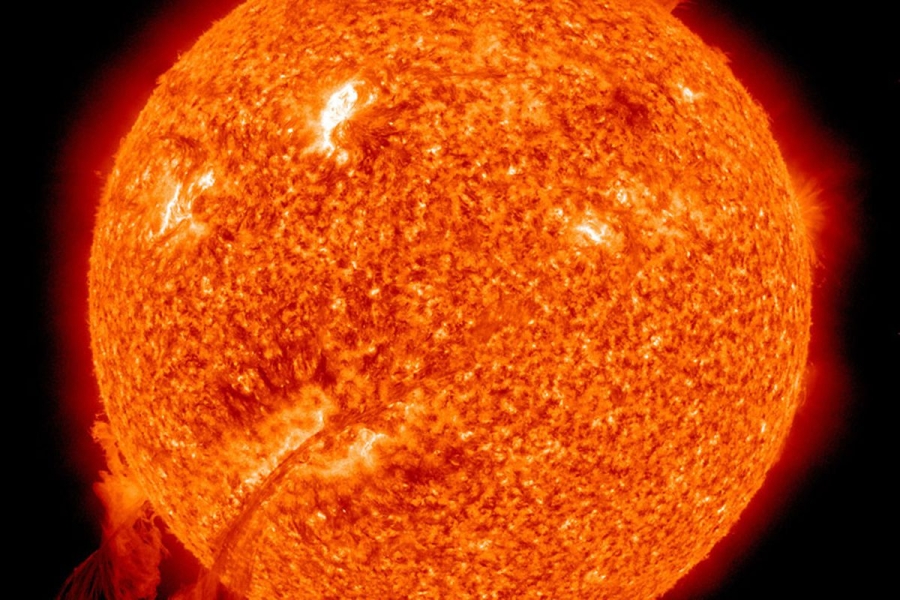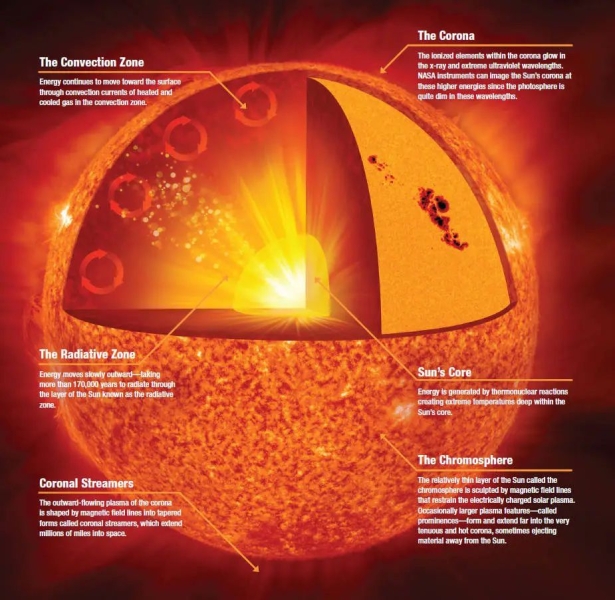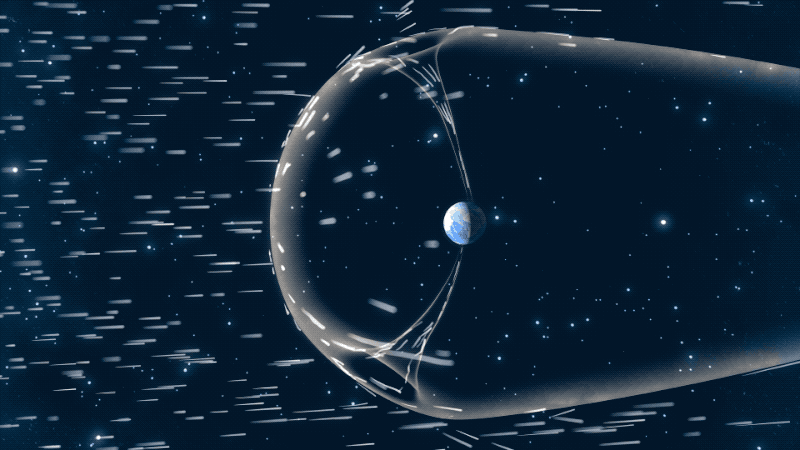The sun is growing feistier. Great news for aurora watchers. Bad news for communication satellites.

Brian Resnick is Vox’s science and health editor, and is the co-creator of Unexplainable, Vox’s podcast about unanswered questions in science. Previously, Brian was a reporter at Vox and at National Journal.
The sun is getting ready to flip.
Every 11 or so years, the sun undergoes an epic transformation: its magnetic poles reverse. Like on Earth, the sun has a magnetic North and a magnetic South. But unlike Earth, whose poles flip on the order of hundreds of thousands of years, the sun’s shuffle is a regular occurrence. The sun’s poles last reversed in 2013. So we’re just about due — likely starting some time this year.
The solar poles flipping is not, as it might sound, the sign of impending apocalypse. You won’t notice it when it happens. The solar cycle only minorly impacts the climate here on Earth. But it’s what happens before the flip that can cause trouble.
Leading up to the pole reversal is a time of increasingly intense magnetic activity on the surface of the sun. That’s what’s happening right now. “We are indeed seeing the sun more active than it’s been in probably something like 20 years,” says Paul Charbonneau, a solar physicist at the University of Montreal.
During these peak periods of solar activity, it’s the most extravagant fireworks display in the solar system. “When the magnetic energy content of the sun is a lot larger, that’s when you tend to get more solar flares, more [coronal] mass ejections — more fun stuff,” Charbonneau says.
Of particular concern are coronal mass ejections. These are explosions that hurl charged matter like shotgun shot across the solar system — aka a “solar storm.” If these storms reach our planet, they have the ability to disrupt communications satellites in space, of which there are an ever-increasing number, thanks to internet provider satellites like Elon Musk’s Starlink. If the conditions are just right, they even take parts of our energy grid on the ground offline.
But in the eyes of scientists, this active time in the solar cycle doesn’t represent peril — it presents ample opportunity. An active period of solar activity gives researchers an opportunity to study the sun in greater detail to serve two big goals: One, they want to better predict when a solar storm might wreak havoc on Earth and on spacecraft. Scientists want to take the progress meteorologists have made in predicting weather on Earth, and forecast space weather. Doing so could allow for safer space travel as interest in crewed missions to the moon, and Mars, gain momentum.
And two, to better understand the mysterious interior of the sun, which generates such awe-inspiring shows, and could help us understand countless other stars in the universe, and eventually a clue to the ultimate mystery: why are we here?
The sun is, basically, an enormous nuclear-powered magnet
At its core, the sun fuses together hydrogen atoms, forming helium, and releasing a massive amount of energy in the process.
What happens outside of that core is less clear, as scientists can’t study the interior of the star directly. For one, it exists 93 million miles away from us, and the bright, violent activity on the surface obscures the beast that lurks underneath.
But outside the core, in a layer called the “convective zone,” the heat generated from the fusion in the core superheats gas into plasma (i.e., gas so hot it has an electrical charge). That plasma, scientists think, moves around the interior of the sun similar to the way water in our ocean moves in great convecting currents, with warmer water rising and cooler water sinking, or how the atmosphere on Earth produces great jet streams.

Here on Earth, this movement of air and water influences the climate and the weather, mainly by transporting and distributing heat from the equator to the poles.
On the sun, something more epic happens because it’s not just transporting heat, but electromagnetism, too.
“We think these flows are the ones that are responsible for generating strong electric currents,” Nour Rawafi, an astrophysicist at Johns Hopkins Applied Physics Laboratory, says. “And whenever you create currents, you create magnetic fields.”
(Think of the classic demonstration you probably saw conducted in elementary school: If you wrap an electrical wire around a nail, and connect it to a battery, that nail will become a magnet.)
This process by which the sun generates magnetism is called the solar dynamo. And much of how it works is still a mystery to solar physicists because it’s hidden from our direct view.
But on the surface of the sun, we can see the power of the dynamo. If the flows of plasma and magnetism inside the sun become unstable, “they pop through the surface, and the magnetic fields are so intense that they appear as dark spots,” says Scott McIntosh, a solar physicist and the deputy director of the National Center for Atmospheric Research. Researchers call these “sunspots” (see them in the image below). They appear like freckly blotches on the surface of the sun.
The area of magnetism acts like a lid on the sun’s heat and light. Through a telescope, they “look dark and cold relative to their surroundings,” McIntosh says. (To be sure: they are still incredibly hot — around 6,500 degrees Fahrenheit — and bright. That’s just relatively cooler than the sun’s typical 10,000-degree surface temperature.)

There’s no analog for sunspots here on Earth. It’s as if a section of the jet stream popped out of our atmosphere and into space, and obscured an astronaut’s view of the continents underneath.
Astronomers have been observing these sunspots with telescopes for centuries, and they noticed a pattern. Every 11 years, the number of sunspots on the surface of the sun reaches a maximum. In the 1950s and early 60s, researchers realized the increase in the number of sunspots precedes the poles reversing. (This April’s solar eclipse over the United States should benefit from occurring near the peak of the solar cycle. If you get to see the eclipse in totality, you could potentially spot looping areas of magnetism emanating out of the solar atmosphere.)
But before the poles flip, monsters can emerge from these sunspots. That is, monstrous solar flares, which are bright explosions of electromagnetic radiation (including visible light, x-rays, and ultraviolet radiation), and coronal mass ejections.
Of particular concern are coronal mass ejections. They are explosions that send the sun’s plasma, and charged particles, racing at hundreds of thousands of miles per hour through the solar system. They can arrive at Earth in “typically three days,” says Delores Knipp, an aerospace engineering professor at the University of Colorado Boulder.

Once here, the effects can range widely. A lot of the time, the Earth’s own magnetic field will simply deflect the storm, like rain bouncing off a cosmic umbrella. In other instances the storm “can actually open up Earth’s magnetic field and allow much more energy and mass to enter in through,” she says, “and when that happens, then we tend to see all kinds of impacts.”


On the mild end, they could result in more vivid auroras visible in lower latitudes on Earth. Auroras are the result of charged particles from the sun colliding with gas in our atmosphere. The deflecting power of Earth’s magnetic fields is weakest at the poles — which is why auroras typically happen near them. But they can occasionally drift closer to the equator, and even appear above the lower 48 in the United States.
If it’s a whopper, it could spell a multitude of disasters. Solar storms can disrupt communications satellites and GPS in space, and, on the ground, potentially disable parts of the electrical grid. Just as electrical flows can induce magnetism, magnetism can induce electrical current. “Our power grids are amazingly effective at being a kind-of antenna for that kind of change in magnetic field,” Knipp says.
The possibility of a direct hit by a powerful solar storm is rare. But it can happen. In 1859, a storm called the “Carrington Event” occurred near the peak of the solar cycle, and sent currents surging through nascent telegraph lines, sparking fires and stymieing messages, according to NASA. Auroras could be seen as far south as Mexico City. If a similar event happened today, risk analysts at Lloyds of London estimate, it could cost trillions.
During the last period of high solar activity in 2012, scientists spotted a couple of coronal mass ejections which crossed the Earth’s orbit. Luckily, our planet was not in the crosshairs. But “had those bursts hit the Earth’s magnetic field,” Brad Plumer wrote in Vox in 2014, “they could have induced strong ground currents capable of overloading our electric grids and knocking out transformers, leaving entire regions without power.”
The unique opportunity this year holds for solar science
The above is a simplified description of how our star works. But many pieces are missing. Scientists don’t have a perfect working model of its dynamo — the process by which the motion of plasma and charged particles inside the sun builds up magnetic energy. It means we’re still not very good at predicting why some solar cycles are more intense than others (indeed, it was predicted that this current — very active — solar cycle would be much milder.)
Currently, scientists can’t predict when a coronal mass ejection will erupt. And they are still working on building forecast models to predict how and when a solar storm would arrive at the Earth.
Figuring out what the sun is up to is “is not really just an academic debate anymore,” says McIntosh, “because of the growing commercial aerospace sector.” The number of satellites orbiting the Earth has exploded by the thousands in recent years. Elon Musk’s Starlink system — designed to give internet service from space — alone involves more than 4,000 of them. All of them — plus more communications and GPS satellites — can be impacted, or potentially destroyed by space weather.
And the deeper humans venture into space, the more exposed they are to dangerous storms. Mars, a target for human exploration, doesn’t have a magnetic shield like the Earth does. So “the ability to predict and preserve astronauts on Mars is a direct result of our capabilities to observe all the sun,” McIntosh says.
Luckily for this solar cycle, scientists have a few new instruments to make critical observations.
First, there’s the European Space Agency’s Solar Orbiter, which launched in 2020, orbiting the sun. It’s designed to make the first-ever direct observations of the sun’s poles. Importantly, “the solar poles hold key secrets to understanding the solar cycle,” Rawafi says. It’s where the polarity reversal happens. What happens at the poles “seeds the future solar cycles. So, understanding the solar poles will help us maybe predict solar cycles in the future.”
Then, there’s NASA’s Parker Solar Probe, which launched in 2018, and is on its way to a closest-ever approach to the sun, coming within 4 million miles of its surface. The probe can actually fly through coronal mass ejections, making careful measurements of how they accelerate particles across space. Finally, here on the ground is the Inouye Solar Telescope in Hawaii, which came online in 2019, which generated the highest resolution images ever taken of the surface of the sun.
These observatories join others already in orbit and on the ground. The dream is to witness an eruption event on the sun and trace its entire path through space, and to the Earth, with the various observatories. With those observations, scientists can make more accurate forecasts, as meteorologists here on Earth have improved forecasting for storms like hurricanes.
And studying these bursts during the active solar cycle can also help scientists understand the beast itself — the solar dynamo.
“It’s like an iceberg,” McIntosh says of studying a coronal mass ejection or flare. “You’re basically getting a glimpse at the machine,” he says. “And so you have to draw inference from the storms to understand what that big machine is doing in the background.”
Figuring out that big machine would be momentous.
“A lot of people have joked that it’s like the only Nobel Prize you’ll win in solar physics, is by finally understanding its dynamo process,” McIntosh says. That’s partly because the sun is a fairly common type of star; there are billions more like it in our own galaxy. And if scientists can figure out how it works, the knowledge instantly multiplies: Suddenly they know how untold number of stars across the universe work a little more deeply. “It’s highly unlikely that what’s going on in the sun is unique,” McIntosh says, “but it’s the one that’s on our doorstep.”
And with that knowledge could come answers to even bigger questions. Life exists on Earth because of the energy the sun provides. But if the sun was more active, or if Earth’s magnetic shield was less powerful, then life could not be possible. So, understanding how our star works is a piece of the puzzle in understanding how life arises — both here and potentially around other stars.
“We’re trying to understand if we are the exception in this universe,” Rawafi says, “or if there is life elsewhere.” We’ll need to look at other stars to answer that question completely. But, in the meantime, we can make progress by looking at our own.
Source: vox.com






